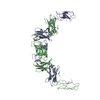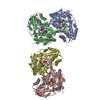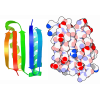+ Open data
Open data
- Basic information
Basic information
| Entry | Database: PDB / ID: 7tad | |||||||||
|---|---|---|---|---|---|---|---|---|---|---|
| Title | CryoEM structure of the (NPR1)2-(TGA3)2 complex | |||||||||
 Components Components |
| |||||||||
 Keywords Keywords | PLANT PROTEIN / NPR1 / TGA3 / Plant Immunity | |||||||||
| Function / homology |  Function and homology information Function and homology informationregulation of salicylic acid mediated signaling pathway / regulation of defense response to bacterium / response to herbivore / regulation of systemic acquired resistance / regulation of jasmonic acid mediated signaling pathway / extracellular ATP signaling / induced systemic resistance / response to insect / negative regulation of defense response / salicylic acid binding ...regulation of salicylic acid mediated signaling pathway / regulation of defense response to bacterium / response to herbivore / regulation of systemic acquired resistance / regulation of jasmonic acid mediated signaling pathway / extracellular ATP signaling / induced systemic resistance / response to insect / negative regulation of defense response / salicylic acid binding / systemic acquired resistance / systemic acquired resistance, salicylic acid mediated signaling pathway / response to salicylic acid / plant-type hypersensitive response / defense response to fungus / transcription coregulator activity / response to bacterium / response to wounding / RNA polymerase II transcription regulator complex / response to heat / calmodulin binding / response to hypoxia / transcription cis-regulatory region binding / defense response to bacterium / nuclear body / protein ubiquitination / DNA-binding transcription factor activity / DNA-templated transcription / positive regulation of DNA-templated transcription / zinc ion binding / nucleus / cytoplasm Similarity search - Function | |||||||||
| Biological species |  | |||||||||
| Method | ELECTRON MICROSCOPY / single particle reconstruction / cryo EM / Resolution: 3.6 Å | |||||||||
 Authors Authors | Wu, Q. / Zhou, Y. / Bartesaghi, A. / Dong, X. / Zhou, P. | |||||||||
| Funding support |  United States, 2items United States, 2items
| |||||||||
 Citation Citation |  Journal: Nature / Year: 2022 Journal: Nature / Year: 2022Title: Structural basis of NPR1 in activating plant immunity. Authors: Shivesh Kumar / Raul Zavaliev / Qinglin Wu / Ye Zhou / Jie Cheng / Lucas Dillard / Jordan Powers / John Withers / Jinshi Zhao / Ziqiang Guan / Mario J Borgnia / Alberto Bartesaghi / Xinnian Dong / Pei Zhou /  Abstract: NPR1 is a master regulator of the defence transcriptome induced by the plant immune signal salicylic acid. Despite the important role of NPR1 in plant immunity, understanding of its regulatory ...NPR1 is a master regulator of the defence transcriptome induced by the plant immune signal salicylic acid. Despite the important role of NPR1 in plant immunity, understanding of its regulatory mechanisms has been hindered by a lack of structural information. Here we report cryo-electron microscopy and crystal structures of Arabidopsis NPR1 and its complex with the transcription factor TGA3. Cryo-electron microscopy analysis reveals that NPR1 is a bird-shaped homodimer comprising a central Broad-complex, Tramtrack and Bric-à-brac (BTB) domain, a BTB and carboxyterminal Kelch helix bundle, four ankyrin repeats and a disordered salicylic-acid-binding domain. Crystal structure analysis reveals a unique zinc-finger motif in BTB for interacting with ankyrin repeats and mediating NPR1 oligomerization. We found that, after stimulation, salicylic-acid-induced folding and docking of the salicylic-acid-binding domain onto ankyrin repeats is required for the transcriptional cofactor activity of NPR1, providing a structural explanation for a direct role of salicylic acid in regulating NPR1-dependent gene expression. Moreover, our structure of the TGA3-NPR1-TGA3 complex, DNA-binding assay and genetic data show that dimeric NPR1 activates transcription by bridging two fatty-acid-bound TGA3 dimers to form an enhanceosome. The stepwise assembly of the NPR1-TGA complex suggests possible hetero-oligomeric complex formation with other transcription factors, revealing how NPR1 reprograms the defence transcriptome. | |||||||||
| History |
|
- Structure visualization
Structure visualization
| Movie |
 Movie viewer Movie viewer |
|---|---|
| Structure viewer | Molecule:  Molmil Molmil Jmol/JSmol Jmol/JSmol |
- Downloads & links
Downloads & links
- Download
Download
| PDBx/mmCIF format |  7tad.cif.gz 7tad.cif.gz | 216.5 KB | Display |  PDBx/mmCIF format PDBx/mmCIF format |
|---|---|---|---|---|
| PDB format |  pdb7tad.ent.gz pdb7tad.ent.gz | 160.8 KB | Display |  PDB format PDB format |
| PDBx/mmJSON format |  7tad.json.gz 7tad.json.gz | Tree view |  PDBx/mmJSON format PDBx/mmJSON format | |
| Others |  Other downloads Other downloads |
-Validation report
| Summary document |  7tad_validation.pdf.gz 7tad_validation.pdf.gz | 831.1 KB | Display |  wwPDB validaton report wwPDB validaton report |
|---|---|---|---|---|
| Full document |  7tad_full_validation.pdf.gz 7tad_full_validation.pdf.gz | 844.1 KB | Display | |
| Data in XML |  7tad_validation.xml.gz 7tad_validation.xml.gz | 42.4 KB | Display | |
| Data in CIF |  7tad_validation.cif.gz 7tad_validation.cif.gz | 64.2 KB | Display | |
| Arichive directory |  https://data.pdbj.org/pub/pdb/validation_reports/ta/7tad https://data.pdbj.org/pub/pdb/validation_reports/ta/7tad ftp://data.pdbj.org/pub/pdb/validation_reports/ta/7tad ftp://data.pdbj.org/pub/pdb/validation_reports/ta/7tad | HTTPS FTP |
-Related structure data
| Related structure data |  25771MC  7mk2C  7mk3C  7tacC  7taeC M: map data used to model this data C: citing same article ( |
|---|---|
| Similar structure data |
- Links
Links
- Assembly
Assembly
| Deposited unit | 
|
|---|---|
| 1 |
|
- Components
Components
| #1: Protein | Mass: 67886.797 Da / Num. of mol.: 2 Source method: isolated from a genetically manipulated source Source: (gene. exp.)   #2: Protein | Mass: 36843.457 Da / Num. of mol.: 2 Source method: isolated from a genetically manipulated source Source: (gene. exp.)   #3: Chemical | #4: Chemical | Has ligand of interest | Y | |
|---|
-Experimental details
-Experiment
| Experiment | Method: ELECTRON MICROSCOPY |
|---|---|
| EM experiment | Aggregation state: PARTICLE / 3D reconstruction method: single particle reconstruction |
- Sample preparation
Sample preparation
| Component | Name: (NPR1)2-(TGA3)2 complex / Type: COMPLEX / Entity ID: #1-#2 / Source: RECOMBINANT |
|---|---|
| Source (natural) | Organism:  |
| Source (recombinant) | Organism:  |
| Buffer solution | pH: 7.5 Details: 25 mM HEPES (pH 7.5), 150 mM NaCl, 2 mM DTT, 0.2 mM salicylic acid. |
| Specimen | Conc.: 1.3 mg/ml / Embedding applied: NO / Shadowing applied: NO / Staining applied: NO / Vitrification applied: YES |
| Specimen support | Grid material: GOLD / Grid mesh size: 300 divisions/in. / Grid type: UltrAuFoil R1.2/1.3 |
| Vitrification | Instrument: LEICA EM GP / Cryogen name: ETHANE / Humidity: 85 % / Chamber temperature: 277.15 K Details: 3 ul of the sample was applied to the grid and incubated for 60 s in the chamber set at 277.15 K and 85% humidity. The grid was blotted for 2.4 s, followed by plunge-freezing in liquid ...Details: 3 ul of the sample was applied to the grid and incubated for 60 s in the chamber set at 277.15 K and 85% humidity. The grid was blotted for 2.4 s, followed by plunge-freezing in liquid ethane cooled by liquid nitrogen. |
- Electron microscopy imaging
Electron microscopy imaging
| Experimental equipment |  Model: Titan Krios / Image courtesy: FEI Company |
|---|---|
| Microscopy | Model: FEI TITAN KRIOS |
| Electron gun | Electron source:  FIELD EMISSION GUN / Accelerating voltage: 300 kV / Illumination mode: OTHER FIELD EMISSION GUN / Accelerating voltage: 300 kV / Illumination mode: OTHER |
| Electron lens | Mode: BRIGHT FIELD / Nominal defocus max: 2000 nm / Nominal defocus min: 1000 nm |
| Image recording | Electron dose: 60 e/Å2 / Film or detector model: GATAN K3 (6k x 4k) |
- Processing
Processing
| Software |
| ||||||||||||||||||||||||
|---|---|---|---|---|---|---|---|---|---|---|---|---|---|---|---|---|---|---|---|---|---|---|---|---|---|
| CTF correction | Type: PHASE FLIPPING AND AMPLITUDE CORRECTION | ||||||||||||||||||||||||
| 3D reconstruction | Resolution: 3.6 Å / Resolution method: FSC 0.143 CUT-OFF / Num. of particles: 287150 / Symmetry type: POINT | ||||||||||||||||||||||||
| Refinement | Cross valid method: NONE Stereochemistry target values: GeoStd + Monomer Library + CDL v1.2 | ||||||||||||||||||||||||
| Displacement parameters | Biso mean: 64.03 Å2 | ||||||||||||||||||||||||
| Refine LS restraints |
|
 Movie
Movie Controller
Controller














 PDBj
PDBj














